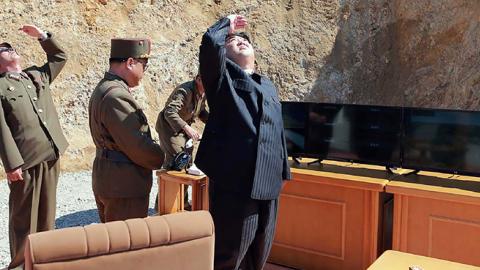The Democratic People’s Republic of Korea (DPRK)’s recent progress in developing nuclear-armed missiles capable of reaching the United States represents the most dangerous threat to global security.
Over the last few months, Pyongyang has tested ever-more powerful ballistic missiles and nuclear-explosive devices.
The DPRK’s new “Hwasong-15” intercontinental ballistic missile (ICBM), launched on November 29, represented a major technological advance. It carried a larger payload with fewer engines. Furthermore, its less blunt nose cone could slow down the speed, and reduce the debilitating heat of a descending re-entry vehicle.
The Hwasong-15 flew farther than any previous DPRK test. Its estimated range, if launched for maximum distance, would have reached some 13,000km, sufficient to hit Washington, D.C., or any other location.
The flight would likely have been shorter had the missile been carrying a reentry vehicle with a heavy nuclear warhead. Still, North Korea is perfecting the technology to miniaturize a nuclear warhead and place it on these missiles. The DPRK is well on its way to acquiring the capacity to attack the entire United States with nuclear-armed missiles.
The November 29 test marked the predictable end of Pyongyang’s proliferation pause. Some analysts had speculated that North Korea was signaling a desire to negotiate by not testing a long-range ballistic missile for 75 days, beyond the 60-day deadline a senior U.S. diplomat had earlier suggested as signaling timeline. This was yet another case of wishful thinking that the DPRK problem would solve itself.
Analysts are debating the reason for the expired testing moratorium, but searching for a specific cause is futile. The DPRK is determined to continue developing its nuclear and missile arsenals. The DPRK leadership openly states that it will not cease its nuclear missile development program until Pyongyang has achieved an “equilibrium of real force” withthe United States — an unbounded force sizing principle.
North Korea seeks the capacity to destroy a major U.S. city in order to deter the United States from attacking from defending the Republic of Korea (ROK), Japan, or other potential targets of DPRK aggression. Pyongyang also wants to dissuade these targets from trusting Washington’s pledges to protect them — inducing them to appease rather than resist DPRK provocations.
The long-term solution to the Korean crisis is internal regime change and reunification under a government that resembles present-day South Korea. Yet, no one knows how long this could take given the ruthless effectiveness of the DPRK’s totalitarian regime.
Neither diplomacy nor sanctions has halted North Korea’s nuclear and missile development. Chinese support for sanctions remains lackluster, with Beijing particularly resisting U.S. calls to suspend its supply of oil to North Korea. Were it ever to become stronger, Russian firms would try to substitute for any foregone Chinese business.
There is no attractive offensive military option available to the United States. A limited preemptive strike might not destroy all of North Korea’s weapons of mass destruction but could well precipitate a massive conventional war on the Korean Peninsula.
Given these unattractive alternatives, the United States should continue to strengthen its defenses in partnership with allies. The recent deployments of the F-35 fighters and THAAD regional missile defenses will help sustain a stable offensive-defense in the Asia Pacific.
At home, the United States can continue to fortify its national defenses against nuclear blackmail. The Ground-Based Midcourse Defense system currently offers the only means of directly defending the continental United States from a long-range North Korean missile attack. Its Ground-Based Interceptors (GBI), located in Alaska and California, are multi-stage rocket boosters equipped with an Exo-Atmospheric Kill Vehicle (EKV), which destroys targets in outer space with kinetic energy.
Their “hit-to-kill” technology has been proven in operational engagements. Earlier this year, the Pentagon’s Operational Test and Evaluation assessed the GBIs as having a “demonstrated capability to defend the U.S. homeland from a small number of intermediate-range or intercontinental missile threats with simple countermeasures,” such as those from North Korea.
The United States needs a comprehensive program to deploy better missile defense capabilities. As regional security expert Danny Lam observed, “successful interception … would weaken the DPRK threat, while a failed intercept will impair US credibility in missile defense.”
Planned hardware and software enhancements to U.S. missile defenses will further improve their capabilities. For example, deployment of the redesigned EKV will increase the kill vehicle’s reliability.
Additionally, the Pentagon has begun to research, design, test, and deploy a more advanced Multi-Object Kill Vehicle that can destroy several targets with one interceptor.
Ongoing augmentations to radars, cyber components, command-and-control systems, and similar networks will also enhance performance. So will more frequently testing U.S. missile defenses against simulated North Korean ICBM-like attacks.
Sustaining adequate funding for modernization of sensors, construction of the new Long Range Discrimination Radar based in Alaska, and other improvements throughout the missile defense infrastructure remain critical.















